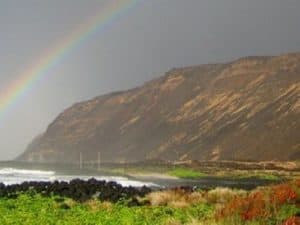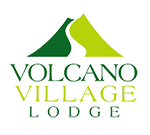Island Info: Windward or Leeward?
 Perhaps you’ve heard the terms windward and leeward when referring to different parts of the Hawaiian Islands. But what exactly do those terms mean? If you’re not an islander, it’s not surprising if you don’t really know. Like the nautical terms port and starboard, you may have a general understanding of their meanings, but, if you aren’t a sailor, you aren’t well versed in their correct usage.
All of the Hawaiian Islands have both a windward and a leeward side. In general terms, the windward side is the wet, rainy, and therefore more lush, green, and tropical section. The windward side faces North or East, where it receives the benefit of the cool, trade-wind breeze. You’ll find the lion’s share of waterfalls here, as well as the majority of the jungle-like, foliage-rich landscapes. While there’s more rainfall on the windward side of the island—that doesn’t mean you’ll never see the sun. Although rain showers are frequent, they’re also sporadic and often take place at night—meaning you’ll hardly miss a beat when touring a windward location.
On the other hand, the leeward side of the island faces South or West and isn’t subject to the trade-wind flow. As a result, the leeward side is generally more abundant in sunshine and less likely to be rainy or cool. Due to its hot, dry nature, the leeward side is lined with fabulous beaches drenched in the sun—and is therefore the side beach-focused vacationers tend to prefer.
On Oahu, the quaint beach town of Kailua, home to Kolea Estates and Pineapple Ohana, is located on the Windward side of the Island. Here, you’re only steps away from several world-class white sand beaches as well as many richly-landscaped tropical habitats. But you’re also just a short drive from the leeward area of Honolulu, where the renowned Waikiki Beach enjoys close to 300 sunny days per year.
On the Big Island—where Volcano Village Lodge and 5th Street Ohana call home—lush, green, and wet are the key elements of the rainforest locale. But while rain is a frequent visitor, it’s not an unwelcomed guest. The moist air feeds the gorgeous landscape, and is therefore the lifeblood of the windward side. The nearby town of Hilo, which is the largest city on the Big Island, is also known as the wettest—with about 280 days of measurable precipitation per year. But don’t let those numbers deter you from visiting—much of the rainfall on the Windward side tends to occur while the city’s asleep, providing an ample amount of sunshine for exploring during the day.
Luckily, no matter where you are when touring the Hawaiian Islands—whether windward or leeward—a differing climate is just a car-ride away. If you’re feeling hot and dry on the leeward coast, head on over to the windward side to see a rainbow and feel the cool breeze; and if you’re rained out on the windward coast, trek nearby to a leeward location to soak up the sun. In Hawaii, there’s beauty in all forms—and on all sides.
Perhaps you’ve heard the terms windward and leeward when referring to different parts of the Hawaiian Islands. But what exactly do those terms mean? If you’re not an islander, it’s not surprising if you don’t really know. Like the nautical terms port and starboard, you may have a general understanding of their meanings, but, if you aren’t a sailor, you aren’t well versed in their correct usage.
All of the Hawaiian Islands have both a windward and a leeward side. In general terms, the windward side is the wet, rainy, and therefore more lush, green, and tropical section. The windward side faces North or East, where it receives the benefit of the cool, trade-wind breeze. You’ll find the lion’s share of waterfalls here, as well as the majority of the jungle-like, foliage-rich landscapes. While there’s more rainfall on the windward side of the island—that doesn’t mean you’ll never see the sun. Although rain showers are frequent, they’re also sporadic and often take place at night—meaning you’ll hardly miss a beat when touring a windward location.
On the other hand, the leeward side of the island faces South or West and isn’t subject to the trade-wind flow. As a result, the leeward side is generally more abundant in sunshine and less likely to be rainy or cool. Due to its hot, dry nature, the leeward side is lined with fabulous beaches drenched in the sun—and is therefore the side beach-focused vacationers tend to prefer.
On Oahu, the quaint beach town of Kailua, home to Kolea Estates and Pineapple Ohana, is located on the Windward side of the Island. Here, you’re only steps away from several world-class white sand beaches as well as many richly-landscaped tropical habitats. But you’re also just a short drive from the leeward area of Honolulu, where the renowned Waikiki Beach enjoys close to 300 sunny days per year.
On the Big Island—where Volcano Village Lodge and 5th Street Ohana call home—lush, green, and wet are the key elements of the rainforest locale. But while rain is a frequent visitor, it’s not an unwelcomed guest. The moist air feeds the gorgeous landscape, and is therefore the lifeblood of the windward side. The nearby town of Hilo, which is the largest city on the Big Island, is also known as the wettest—with about 280 days of measurable precipitation per year. But don’t let those numbers deter you from visiting—much of the rainfall on the Windward side tends to occur while the city’s asleep, providing an ample amount of sunshine for exploring during the day.
Luckily, no matter where you are when touring the Hawaiian Islands—whether windward or leeward—a differing climate is just a car-ride away. If you’re feeling hot and dry on the leeward coast, head on over to the windward side to see a rainbow and feel the cool breeze; and if you’re rained out on the windward coast, trek nearby to a leeward location to soak up the sun. In Hawaii, there’s beauty in all forms—and on all sides. 